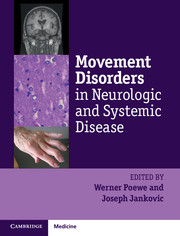Book contents
- Frontmatter
- Contents
- List of contributors
- List of videos
- List of abbreviations
- Preface
- Section I General principles
- Section II Movement disorders in systemic disease
- Chapter 4 Paraneoplastic movement disorders
- Chapter 5 Movement disorders of autoimmune origin
- Chapter 6 Movement disorders in systemic infections
- Chapter 7 Movement disorders in HIV- and AIDS-related central nervous system infections
- Chapter 8 Movement disorders in metabolic diseases in adulthood
- Chapter 9 Movement disorders in childhood metabolic diseases
- Chapter 10 Movement disorders in endocrinological diseases
- Chapter 11 Movement disorders in liver disease
- Chapter 12 Movement disorders in renal diseases
- Chapter 13 Movement disorders in hematological disease
- Section III Iatrogenic and toxic movement disorders
- Section IV Movement disorders in general neurology
- Section V Systemic complications of movement disorders
- Index
- Plate Section
- References
Chapter 9 - Movement disorders in childhood metabolic diseases
from Section II - Movement disorders in systemic disease
Published online by Cambridge University Press: 05 April 2014
- Frontmatter
- Contents
- List of contributors
- List of videos
- List of abbreviations
- Preface
- Section I General principles
- Section II Movement disorders in systemic disease
- Chapter 4 Paraneoplastic movement disorders
- Chapter 5 Movement disorders of autoimmune origin
- Chapter 6 Movement disorders in systemic infections
- Chapter 7 Movement disorders in HIV- and AIDS-related central nervous system infections
- Chapter 8 Movement disorders in metabolic diseases in adulthood
- Chapter 9 Movement disorders in childhood metabolic diseases
- Chapter 10 Movement disorders in endocrinological diseases
- Chapter 11 Movement disorders in liver disease
- Chapter 12 Movement disorders in renal diseases
- Chapter 13 Movement disorders in hematological disease
- Section III Iatrogenic and toxic movement disorders
- Section IV Movement disorders in general neurology
- Section V Systemic complications of movement disorders
- Index
- Plate Section
- References
Summary
Definitions and classification
Inborn errors of metabolism (IEM) represent a vast, diverse, and heterogeneous collection of disorders in which there is a block at some point in the normal metabolic pathway caused by a genetic defect of a specific enzyme. Up to now, more than 500 IEM have been characterized: the great majority are autosomal recessive. Broadly, these IEM may be divided into three groups (Saudubray et al. 2006):
Group 1: Disorders that give rise to an acute or chronic intoxication. It encompasses aminoacidopathies, organic acidurias, urea cycle disorders, sugar intolerances, metal disorders, and porphyrias. This group also includes inborn errors of neurotransmitter synthesis and catabolism, especially monoamine metabolism defects. The disorders included in group 1 share common features: no interference with embryo-fetal development, presentation after a symptom-free interval with chronic or intermittent manifestations sometimes triggered by provoking factors (for example, stress fever, intercurrent illness). Most of these disorders are treatable and require an emergency removal of the toxin by special diets, extracorporeal procedures, cleansing drugs, or vitamins.
Group 2: Disorders involving energy metabolism. This group includes inborn errors of intermediary metabolism that affect mitochondrial energetic processes (respiratory chain disorders, Krebs cycle and pyruvate oxidation defects, fatty acid oxidation disorders) and the cytoplasmic defects of energy metabolism (glucose transport defect, glycolysis, glycogenosis, gluconeogenesis, hyperinsulinisms, and creatine and pentose phosphate pathways). Some of these disorders might interfere with the embryo-fetal development; they give rise to chronic manifestations, sometimes associated with paroxysmal symptoms. Some of these disorders are partly treatable.
Group 3: Disorders involving complex molecules. This group involves cellular organelles and cellular trafficking and processing of complex molecules; it includes lysosomal, peroxisomal, glycosylation, and cholesterol synthesis defects. Symptoms are permanent, progressive, and independent of intercurrent events. Enzyme replacement therapy or bone marrow transplantation are indicated in some lysosomal storage diseases.
- Type
- Chapter
- Information
- Movement Disorders in Neurologic and Systemic Disease , pp. 115 - 130Publisher: Cambridge University PressPrint publication year: 2014
References
- 1
- Cited by

